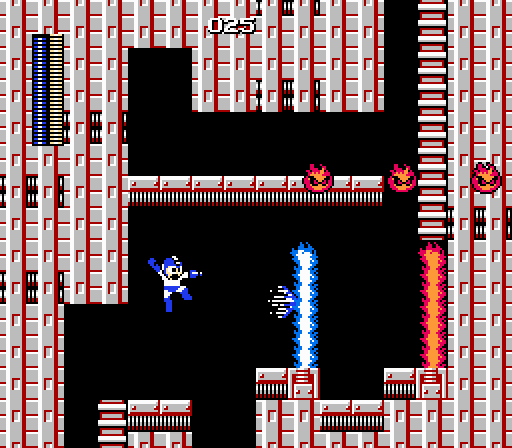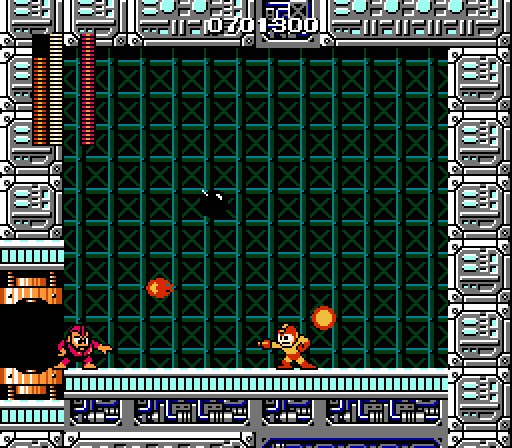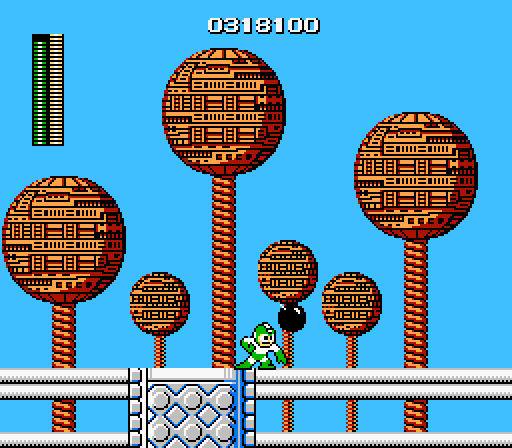Why, hello! Let’s talk some more about Mega Man. And its weapons.
Ice Slasher
Easily the most misleading weapon name in the game, the Ice Slasher does not in fact slash. Unless you use it against Fire Man, who is weak to its icy stylings, the Ice Slasher inflicts no damage whatsoever on foes. Instead, this tool – and I stress tool, because it really doesn’t constitute a weapon in any real sense of the world outside of two limited situations in the course of the game – clearly takes its cues from Metroid‘s Ice Beam. Which would make sense; if you were designing a Famicom platform shooter in mid-to-late 1987, where else would you look but the meatiest, most intricate, most revolutionary expression of the genre to date?
Like Samus’ Ice Beam, the Ice Slasher freezes foes in mid-action. It’s less about turning something cold than inflicting a zero-point stasis on that object, rendering it complete immobile for a brief time regardless of where it may be at the moment. Stationary, running, falling, leaping, whatever – it arrests an enemy, including its inertia, until the effect wears off. Unlike the Ice Beam, however, this weapon doesn’t work like a toggle; shooting a foe a second time once it’s frozen has no effect. The second shot doesn’t render damage, and it doesn’t unfreeze the enemy. However, Mega Man can switch to a different weapon during the freeze duration to pump a frozen foe full of plasma (or peas?), making this device functionally different from, say, Mega Man 2‘s Time Stopper.
Ice Slasher also has the ability to freeze the fire columns that appear early in Fire Man’s stage (and Dr. Wily’s lair), which once again repeats the motif of Mega Man tipping you off to a boss’ weakness with the sandbox elements that appear throughout a stage.
Fire Storm
Really the game’s only weapon to offer a reasonable go-to alternative to the P shooter, the Fire Storm combines reasonable offensive, a low cost for use, a basic movement pattern (the projectile flies straight ahead at a rapid clip), and a moderate defensive element to be quite a helpful device. While expensive enough to use that you can’t make it your new basic weapon in every stage, the Fire Storm works well in most situations.
It’s particularly useful against small, speedy robots with erratic patterns, such as Fleas: The projectiles move quickly and have a wider hit box than standard arm cannon bullets, so they cover a reasonable swath of screen quite nicely. Meanwhile, every time you activate the Fire Storm, a small circular projectile spins rapidly around Mega Man, inflicting damage on anything it touches during its brief orbit. If a quick enemy slips past your cannon fire, the shield bit is likely to take it out.
The Fire Storm is most powerful against Bomb Man. And where do Fleas appear more frequently? That’s right, toward the beginning of Bomb Man’s stage. Honestly, the game is its own strategy guide.
Hyper Bomb
At the other end of the utility spectrum from Fire Storm is the Hyper Bomb, which offers devastating power in a package that practically guarantees you won’t be able to connect with it.
When you “fire” Hyper Bomb, you actually produce a gigantic bomb out of thin air and chuck it in a short, low arc. It’s very cartoon-like. It’s also very impractical, as the bomb doesn’t explode on impact; it’ll pass right through an enemy, bouncing slightly as it burns up the momentum of your toss and comes to a rest. Once it’s stopped moving, it explodes.
The explosion is admittedly powerful and the splash effect is quite wide, so if you manage to time it right the Hyper Bomb just shreds bad guys. The problem is in the timing, though. Few enemies in this game are stationary, and those that remain fixed to a single spot tend to pour bullets onto the screen (such as Screw Turrets) or else spend most of their time securely buckled down beneath some kind of shield (Metool helmets, Sniper Joe shields, etc.). Throwing a Hyper Bomb leaves you vulnerable to the former type’s attacks as you can’t switch between weapons while a bomb is on the screen, and it forces you to try and time your attacks against the latter type to fall within their vanishingly brief windows of opportunity.
The Hyper Bomb can be situationally useful; it’s the only device other than Rolling Cutter capable of destroying a Spine, so in areas where Spines patrol narrow ledges or wells, the wide splash effect of the bombs and the sluggish default movement of the Spines works to your advantage. Otherwise, though, you’ll probably only whip this stupid thing out to fight Guts Man, who is weak to its explosions.
Magnet Beam
Bafflingly, the Hyper Bomb doesn’t even shatter destructible walls the way the Thunder Beam does. Which means, idiotically, you can’t use it to get the final “weapon” in the game: The Magnet Beam.
The Magnet Beam is weird. It’s clearly a precursor to Mega Man 2‘s Items 1 through 3 and Mega Man 3‘s Rush devices, but its presence in the game feels haphazard. It appears in a seemingly random location during the climb up the middle portion of Elec Man’s stage, hidden behind a few blocks that can only be cleared away with the Thunder Beam (which obviously you won’t have during your first fight through Elec Man’s area) or the Guts Arm (which you’re not likely to have if you take the “default” order of bosses and take on Cut Man first and Guts Man last). In fact, until you get really good at the drop lifts at the beginning of Guts Man’s stage, you probably can’t even clear that level until you acquire the Magnet Beam!
Worse, once you reach Dr. Wily’s lair, the area above requires you to have the Magnet Beam in hand – there’s no other way to reach the latter high in the ceiling. But once you get to the Dr. Wily phase of the game, you can’t exit out of his stage, even at the Game Over screen. So if you pass up the Magnet Beam, you render the game unwinnable. Whoops.
As tools go, though, it’s worth acquiring as quickly as possible. The Magnet Beam fires out a harmless line of persistent beams that allow Mega Man to hop aboard and use them as platforms. The rays only stay on screen for a few seconds, and it can be tough to gauge their presence thanks to the NES’ hardware quirks (the console had very limited capabilities when it came to rendering multiple sprites on the same line, so the beams flicker to the point of near-invisibility while they’re active). But despite these drawbacks, the ability to create your own platform is invaluable in certain areas. The drop lifts in Guts Man’s stage, for example. Or the vast gulfs of empty space with those stupid glitchy attack platforms in Ice Man’s level. Or the vanishing block mazes.
In fact, that’s the saving grace for the Magnet Beam/Dr. Wily design oversight: The tool is so useful in certain annoying stages that any sane player will prioritize its acquisition to avoid having to deal with the game’s more annoying platforming sequences. Despite its flaws, the Magnet is an interesting element that echoes the influence of arcade-style action adventure games like Tower of Druaga and, yes, The Goonies, giving the player an extra tool for ease of play that exists outside their standard arsenal. Unfortunately, it’s not optional, even though it’s kind of presented that way… but the team learned from their design mistakes for future games. And isn’t that what sequels are all about?




If I remember correctly, they just tossed the Magnet Beam entirely in Mega Man Powered Up, save for the old style mode.
The other interesting feature of the Magnet Beam is that it can be used to break the game repeatedly by forcing Mega Man into walls. But doing this purposefully requires some pretty extreme precision, so it’s mainly seen in tool-assisted runs and other such shenanigans.
The weapons in the first Mega Man are actually designed pretty differently from the rest of the series. In the later games, it even starts to seem like every game has the same weapons in it:
- The one that destroys breakable walls (Crash Bomber, Hard Knuckle, Drill Bomb, Flame Blast)
- The one that creates a barrier around you (Leaf Shield, Skull Barrier, Star Crash, Plant Barrier)
- The one that hits the entire screen and can only be used 7 times on a full meter (Rain Flush, Gravity Hold, Centaur Flash)
- The weird novelty move that you never use (Top Spin, Charge Kick) (I’m a Top Spin apologist, though. I maintain that it’s the best thing to use against the dragonfly and walking eyeball enemies. Both of which, amazingly enough, appear in Shadow Man’s stage. It’s really true that the game is its own strategy guide.)
- And 4 more weapons that just shoot a projectile of some sort, and their defining feature is the trajectory of same.
But rather than following that formula, the original Mega Man seems preoccupied with weapons that more or less shoot straight forward, but have some sort of AOE aspect. Out of 6 secondary weapons, you’ve got 4 of them that are designed to hit a wide area of the screen. 5, if you count the barrier around you when you use Fire Storm. It makes sense in a way, what’s better than shooting one guy? Shooting a whole bunch of guys, obviously. But I think the weapon selection in the later games made for more varied and interesting gameplay.
The Magnet Beam definitely could have stood to make some more appearances, though. Maybe they got bad feedback about it from people that were mad about getting stuck in that room in Dr. Wily’s castle, but all that would really need to be done to fix that is to make it inevitable that the player will pick it up before any rooms that require it. Like, for instance, the forced use of Item-1 in the first stage of Dr. Wily’s castle in Mega Man 2. Or, hell, like the first stage of Sigma’s fortress in Mega Man X, where Zero gives you the arm upgrade if you don’t already have it, even though it would be possible to finish the game without it.
Ha, that desire to get the Magnet Beam first only holds true if you know what the hell it is. First time I played MM1 it was a rental without a manual (because the game was impossible to find in stores - eventually bought it from a pawn shop). Though I suppose the shear mystery of the item was enough enticement to get it as soon as possible 😛
That being said, played through it again this weekend. MY GOD the stupid platforms in Ice Man’s stage. That’s some serious bull crap right there. Wanted to be all good and do it without Magnet Beam but it’s so buggy that it’s impossible.
I always thought the flickering Magnet Beam were exploiting the system’s limitations for an intentional effect; is it NOT meant to appear as though it could give way at any moment? And sure enough, it will 😛
I am not a big fan of the weapon selection in 1 due to the supreme nicheyness of some of the choices and the general lack of variety compared to subsequent games. I particularly miss having anything more efficient than one bar per shot, but of course that will be pioneered soon enough. The weapons in this mostly serve as a means of completely outclassing the right Robot Master — three shots usually does it whereas very few future bosses withstand less than seven hits from their weakness.